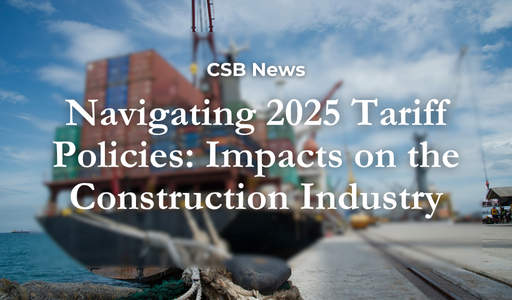Navigating 2025 Tariff Policies: Impacts on the Construction Industry
As of mid-2025, U.S. tariff policies are undergoing significant changes that are reshaping the construction landscape. For contractors, understanding these shifts is important to managing costs, maintaining project timelines, and staying competitive in a volatile market.
Current Tariff Landscape
The U.S. has implemented a series of aggressive tariff increases under the current administration. Key developments include:
- Tariffs on all steel and aluminum imports, affecting structural materials and fabrication costs. The tariffs imposed in April 2025 were increased effective June 3, 2025, from 25% to 50%.
- 25% tariffs on imports from Mexico and Canada, with limited exemptions under the United States-Mexico-Canada Agreement (USMCA).
- Proposed 25% tariffs on copper and lumber, which are still pending but could significantly affect electrical and framing costs.
- 10% tariffs on potash and energy products, indirectly influencing construction through increased fertilizer and fuel prices.
Impacts on Construction Contractors
Rising Material Costs
Tariffs on steel, aluminum, and lumber have raised prices across the industry. These cost increases may result in diminished profit margins, making it harder to stay within budget.
Supply Chain Disruption
Tariffs have disrupted long-standing supply chains. Contractors may face delays in material deliveries resulting in the need to seek alternative sources.
Project Delays and Budget Overruns
With materials harder to source and more expensive, project timelines are likely to stretch. Contractors should build in contingencies for procurement and pricing volatility, as these factors can complicate client negotiations and contract agreement.
Strategic Shifts in Procurement
Many firms are turning to domestic suppliers. While this can reduce exposure to tariffs, it may also introduce new challenges in terms of capacity, quality, and pricing.
What Contractors Can Do
While some tariffs may be temporary or subject to negotiation, the current trend suggests a protectionist trade environment for the near future. Contractors who adapt quickly and build flexibility into their operations will find themselves better positioned.
A way to facilitate this is with a mid-year financial review, which allows management to assess project profitability, cash flow, and budget performance across ongoing jobs as well as the organization. These factors are often impacted by fluctuating material costs and labor availability. With the added complexity of tariffs on imported construction materials such as steel, aluminum, and lumber, contractors face increased cost volatility. A thorough mid-year check-in helps identify where tariffs may be inflating expenses, enabling contractors to adjust estimates, renegotiate supplier terms, or explore alternative sourcing. This proactive approach ensures better financial control, supports accurate forecasting, and strengthens the contractor’s ability to navigate a dynamic and often unpredictable market.
CSB can provide assistance in this area. Please reach out to your CSB contact to discuss questions or concerns.
The tariffs referenced above reflect tariff policy as of July 15, 2025. Tariffs on these goods may vary due to future changes in tariff policy or based on the specific policies regarding the countries from which the goods are imported.

Kirsten Sokom
Principal
Audit services for construction, manufacturing, and distribution companies; engagement quality control and best practices.


